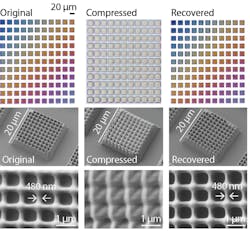Cascaded microfluidic AO system for microscopy is simple, compact

In microscopy, any mismatch between the refractive indices of the sample and its immersion medium, deviations in cover-glass thickness, or effects of aging on the instrument can produce focusing errors and spherical aberration. In addition, particularly for deep tissue imaging, any inhomogeneous refractive index of the sample and its complex surface shape can lead to additional higher-order aberrations. Now, researchers at the University of Freiburg (Germany) have made a significant advance in adaptive optical (AO) microscopy by demonstrating a new AO module comprising two compact optofluidic deformable phase plates (DPPs). In contrast to deformable mirrors, the DPP system is a wavefront modulator that operates in transmission, enabling direct AO integration with existing microscopes. In this AO configuration, one of the optical modulators is optimized for low-spatial-frequency aberrations while the second is used for high-frequency correction.
Each DPP has an optofluidic chamber with glass on one side and a deformable membrane on the other; electrostatic actuators enable deformation of the membrane. The device has no diffraction effect and is independent of polarization. The experimental versions had a clear aperture of 9 mm, a response time of better than 80 ms, and either 25 radially patterned or 37 hexagonally patterned electrodes. A major challenge for an AO system with multiple phase modulators is how to place them at optically conjugate positions, which often requires multiple additional optical components to relay the image. Therefore, configuring even two modulators in an AO system is challenging. Because the new DPPs are only 0.61 mm in thickness, placing two or more modulators close together (cascading them) becomes practical.
To demonstrate its performance, the team integrated the new AO system into a custom-built fluorescence microscope where sample-induced aberrations are iteratively estimated without a wavefront sensor. Imaging experiments on synthetic samples demonstrated that the new AO system can reproduce Zernike modes up to the sixth radial order and doubles the aberration-correction range. The work demonstrates that more advanced aberration correction schemes, such as multiconjugate adaptive optics, can be implemented as easily and with new and more advanced control methods. Reference: P. Rajaeipour et al., Adv. Photonics (2021); doi:10.1117/1.ap.2.6.066005.
About the Author
John Wallace
Senior Technical Editor (1998-2022)
John Wallace was with Laser Focus World for nearly 25 years, retiring in late June 2022. He obtained a bachelor's degree in mechanical engineering and physics at Rutgers University and a master's in optical engineering at the University of Rochester. Before becoming an editor, John worked as an engineer at RCA, Exxon, Eastman Kodak, and GCA Corporation.
